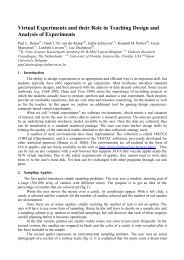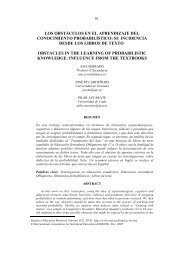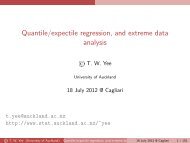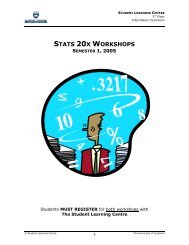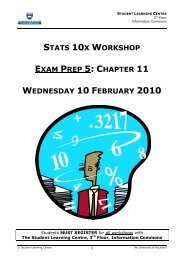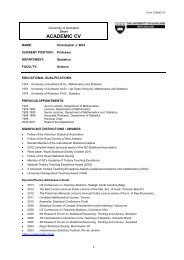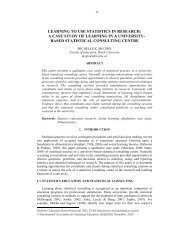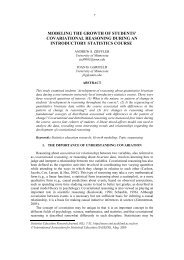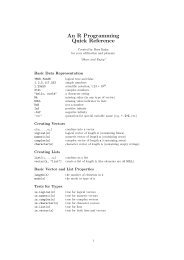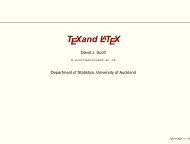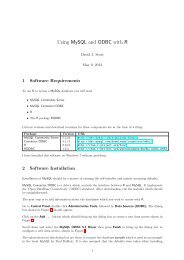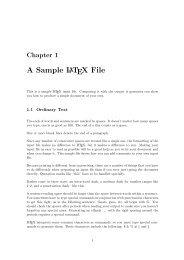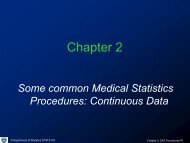The beamer class
The beamer class
The beamer class
You also want an ePaper? Increase the reach of your titles
YUMPU automatically turns print PDFs into web optimized ePapers that Google loves.
files constitute the Work. This could, for example, be achieved by explicitly listing all the files of the Work<br />
near the copyright notice of each file or by using a line such as:<br />
% This work consists of all files listed in manifest.txt.<br />
in that place. In the absence of an unequivocal list it might be impossible for the licensee to determine<br />
what is considered by you to comprise the Work and, in such a case, the licensee would be entitled to make<br />
reasonable conjectures as to which files comprise the Work.<br />
7.4 GNU Free Documentation License, Version 1.2, November 2002<br />
7.4.1 Preamble<br />
<strong>The</strong> purpose of this License is to make a manual, textbook, or other functional and useful document “free”<br />
in the sense of freedom: to assure everyone the effective freedom to copy and redistribute it, with or without<br />
modifying it, either commercially or noncommercially. Secondarily, this License preserves for the author and<br />
publisher a way to get credit for their work, while not being considered responsible for modifications made<br />
by others.<br />
This License is a kind of “copyleft”, which means that derivative works of the document must themselves<br />
be free in the same sense. It complements the GNU General Public License, which is a copyleft license<br />
designed for free software.<br />
We have designed this License in order to use it for manuals for free software, because free software needs<br />
free documentation: a free program should come with manuals providing the same freedoms that the software<br />
does. But this License is not limited to software manuals; it can be used for any textual work, regardless<br />
of subject matter or whether it is published as a printed book. We recommend this License principally for<br />
works whose purpose is instruction or reference.<br />
7.4.2 Applicability and definitions<br />
This License applies to any manual or other work, in any medium, that contains a notice placed by the<br />
copyright holder saying it can be distributed under the terms of this License. Such a notice grants a worldwide,<br />
royalty-free license, unlimited in duration, to use that work under the conditions stated herein. <strong>The</strong><br />
“Document”, below, refers to any such manual or work. Any member of the public is a licensee, and is<br />
addressed as “you”. You accept the license if you copy, modify or distribute the work in a way requiring<br />
permission under copyright law.<br />
A “Modified Version” of the Document means any work containing the Document or a portion of it,<br />
either copied verbatim, or with modifications and/or translated into another language.<br />
A “Secondary Section” is a named appendix or a front-matter section of the Document that deals<br />
exclusively with the relationship of the publishers or authors of the Document to the Document’s overall<br />
subject (or to related matters) and contains nothing that could fall directly within that overall subject.<br />
(Thus, if the Document is in part a textbook of mathematics, a Secondary Section may not explain any<br />
mathematics.) <strong>The</strong> relationship could be a matter of historical connection with the subject or with related<br />
matters, or of legal, commercial, philosophical, ethical or political position regarding them.<br />
<strong>The</strong> “Invariant Sections” are certain Secondary Sections whose titles are designated, as being those of<br />
Invariant Sections, in the notice that says that the Document is released under this License. If a section does<br />
not fit the above definition of Secondary then it is not allowed to be designated as Invariant. <strong>The</strong> Document<br />
may contain zero Invariant Sections. If the Document does not identify any Invariant Sections then there<br />
are none.<br />
<strong>The</strong> “Cover Texts” are certain short passages of text that are listed, as Front-Cover Texts or Back-<br />
Cover Texts, in the notice that says that the Document is released under this License. A Front-Cover Text<br />
may be at most 5 words, and a Back-Cover Text may be at most 25 words.<br />
A “Transparent” copy of the Document means a machine-readable copy, represented in a format whose<br />
specification is available to the general public, that is suitable for revising the document straightforwardly<br />
with generic text editors or (for images composed of pixels) generic paint programs or (for drawings) some<br />
widely available drawing editor, and that is suitable for input to text formatters or for automatic translation<br />
to a variety of formats suitable for input to text formatters. A copy made in an otherwise Transparent<br />
file format whose markup, or absence of markup, has been arranged to thwart or discourage subsequent<br />
modification by readers is not Transparent. An image format is not Transparent if used for any substantial<br />
amount of text. A copy that is not “Transparent” is called “Opaque”.<br />
48



